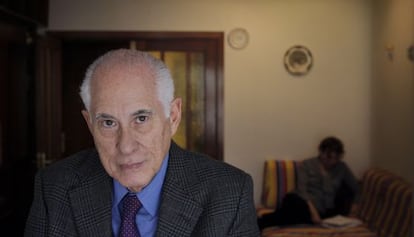Carmelo Mesa-Lago: ‘China and Vietnam demonstrate the failure of Cuba’s economic-social model’
The professor, exiled in the US since 1961, identifies for EL PAÍS a series of factors, among them the embargo, which influence the poor results of the Cuban economy

With more than 60 years of research behind him and 95 books published, most of them on Cuba and on social security issues, economist Carmelo Mesa-Lago is an essential source to understanding and interpreting the present Cuban reality and its future. Professor emeritus at the University of Pittsburgh and consultant to numerous international organizations, a member of the US National Academy of Social Security and the Academy of Sciences of Latin America, Mesa-Lago is respected for his scientific rigor on both sides of the Florida Straits. He left Cuba in 1961, but since he arrived in the United States he has spoken out for moderation and against the US embargo policy, all of which he was criticized for by the most combative wing of the Cuban exile.
He believes that Cuba is experiencing one of the worst crises in its history and that the timid economic reforms implemented so far have failed and are insufficient to lift the country out of chaos and lay the foundations for development. He has just finished a massive research project – conducted over two years – in which he compares two socialist economic models: Cuba, still with its central planning and partial and ineffective reforms, and the successful model of market socialism of China and Vietnam. He also compares the impact of these models on the social protection systems of the three countries. “We know that the two Asian countries have far surpassed Cuba in their economic performance, but what my work proves is that the same has happened on the social level, despite the fact that when their revolutions occurred, China and Vietnam were well below Cuba in social indicators.”
Question. Cuba has gone through numerous crises, but you say in your latest articles that this is one of the most severe in its history.
Answer. The crisis of the 1990s was caused primarily by the collapse of the USSR and Eastern European socialism. The first granted Cuba $65 billion between 1960 and 1990, including oil supply, large investments, soft trade credits and substantial price subsidies, so the blow was devastating. The current crisis doesn’t have a single cause but many intertwined. The main one is the inefficient Cuban economic model and the failure of the modest market-oriented reforms implemented by Raúl Castro. Moreover, it is a crisis extended for a long period of time, preceded by stagnation (from 2009 to 2018), culminating in a sharp fall in gross domestic product (GDP) in 2019-2020. In the nineties, Fidel Castro led the country and introduced reforms that managed to stop the crisis in 1994 and initiate a partial recovery later. Now, there is neither a leader of his caliber, nor profound reforms to get Cuba out of this situation.
Q. What is the real magnitude of this crisis?
A. According to the latest statistical data offered by Cuba, between 2019 and 2021 the economy contracted at an average annual rate of 3.3%. In 2020, GDP fell by 10.9%, the worst performance in Latin America after Venezuela. The government admits that in 2021 inflation was 60%, but experts estimate that in reality it shot up between 270% and 470%, one of the highest rates in the world. The depreciation of the Cuban currency – after the monetary unification initiated in 2021– is considered the worst among the 15 most internationally depreciated currencies. Industrial production declined 45 percentage points between 1989, the eve of the collapse of the USSR, and 2021. Agricultural production shrank by an average of 7.7% per year in 2016-2021. The 2021-2022 sugar harvest was 420,000 metric tons, the worst in history, only 5% of the average of 8 million tons produced in the eighties. The value of merchandise exports in 2021 was 67% lower than the 1989 level. On the social front, inflation-adjusted wages fell 46% between 1989 and 2020, while the average pension decreased by one third. Neither can meet the basic food needs. In 2021, 35.2% of the country’s total investment was allocated to business, real estate and rental activities (basically hotel construction) compared to 2.7% for education and health. Since 2007, social spending has been cut substantially.
Q. Is it possible to get out of this hole with the policies that are being implemented?
A. It is not feasible to get out of the crisis with the current policies because, with few exceptions, they are a continuation of Raúl Castro’s policies of the past eleven years, which were not successful. The most important measure, monetary unification, which Cuban academic economists had been calling for for more than a decade, was done at the worst time and badly; as a result, it has led to the highest inflation in Cuban history. The authorization of small- and middle-size private enterprises is positive, but some 6,000 have been registered, equivalent to 1% of the self-employed with small businesses.
Q. How much does the US policy of economic embargo play a role?
A. Firstly, I have been publicly against the embargo since 1970 and supported President Obama’s policy of normalizing relations with Cuba. Second, I believe that on this issue there are two antagonistic positions, both simplistic, partial and biased: Cuba blames all its problems on the embargo or blockade, while the right attributes them to the communist regime. In several recent works I have argued that it is actually a set of factors that have caused the crisis. Of course, the tightening of the embargo by Donald Trump, who activated the Helms-Burton Act, drastically reduced flights and banned cruises to Cuba, imposed limits on remittances and prohibited Western Union from sending money orders, in addition, he toughened sanctions on international banks that make transactions with Cuba. Biden has relaxed this policy somewhat but maintains most of the sanctions, although it is speculated that he is preparing a change of strategy. The economic-humanitarian crisis in Venezuela, which caused a significant reduction in its economic aid and oil supply to Cuba, has been very important. The pandemic also severely affected tourism, remittances, etc., and the effects of the war in Ukraine pushed up prices of oil and food. But the main cause is the inefficient Cuban economic model that, with variations, has been in place for 62 years and has failed all over the world.
Q. You have just finished an investigation that compares the economic-social models of Cuba, China and Vietnam. All three are socialist countries, are there really so many differences?
A. The Cuban model is characterized by the central plan and large state enterprises dominant over the market and private property, with timid and incomplete reforms that have resulted in two severe economic-social crises. On the contrary, in the successful Sino-Vietnamese model of market socialism, small, medium and some large private enterprises and the market predominate under a decentralized plan, which is more a guide to development than a straight jacket, where the state regulates the economy and controls the largest enterprises. For example, the share of the state sector in GDP has declined substantially in the two Asian economies: in 2019, the proportions were 27% in Vietnam and 31% in China, vis-à-vis 91% in Cuba.
At the same time, the share of the private sector in GDP has grown rapidly in China and Vietnam and is today the most dynamic factor in the economy. In Cuba, the small expansion of the private sector has been hampered by bureaucratic obstacles, regulations, heavy taxes and faces the uncertainty created by policy zigs-zags. In Cuba, for example, professionals (engineers, architects, doctors, etc.) cannot practice their profession as individuals, but they can work renting a home to tourists, or as taxi drivers or restaurant owners, which encourages many professionals to leave their state jobs that pay a miserable salary and move to the private sector where they earn much more, or leave the country. These bans do not exist in China or Vietnam. In these two countries, a farmer can freely decide who to sell the produce and set its price by supply and demand. In Cuba, all non-state producers are obliged to sell a portion of their harvest to the state (sometimes up to 70%) at prices set by the government below the market price. China, which historically suffered periodic famines, is now self-sufficient in food and Vietnam generates a large agricultural surplus that it exports. It is already the world’s second largest exporter of rice. If Cuba followed a similar agrarian policy, in a few years the severe food shortage and the need to import about 80% of what it consumes, at the cost of $2 billion per year, would end.
Q. What has been the economic and social performance of these two models?
A. In my research, which I hope will be published as a book later this year, I use 20 economic and ten social indicators to compare the performance of the two models. While Cuba has suffered stagnation and decline in its economy, in the period 2009-2020 China’s average annual GDP rate grew almost eight times the average of Cuba and Vietnam’s five times. Industrial production between 1989 and 2020 in China increased 153 percentage points and in Vietnam 57 points, while in Cuba it decreased 45 points. Healthcare is usually considered one of the areas of greatest progress in Cuba. This was true in 1989, when the island was ranked among the first Latin American countries and among the Eastern European socialists; but the crises of the nineties and the current one, have caused a severe setback. For example, the maternal mortality rate per 100,000 live births that in 2017 was 39.1 in Cuba, in 2021 shot up to 176.6, which represents a regression to the level of the 50s, while in China it was 17.8 and in Vietnam 46. Between 1989 and 2020, the average annual inflation-adjusted wage rose 289% in Vietnam and 217% in China, but fell 46% in Cuba. Social indicators are especially relevant, since it must be taken into account that, at the time of their revolutions, the two Asian countries had a much lower level of economic and social development than Cuba, so they required a greater effort to match and surpass it. Based on the average of the order of the 20 indicators of my research, China ranked first, Vietnam second and Cuba third.
Q. Your work also compares the performance of the three countries in terms of social security and protection, what are the results?
A. I focus on the three main social security programs: pensions, health and social assistance. To evaluate the performance, I use 150 indicators grouped by the principles of social security developed in more than a century by the International Labor Organization: coverage of the labor force in pensions, of the total population in health and of the elderly population in social assistance; adequacy of benefits or benefits; social solidarity and gender equity; administrative efficiency at a reasonable cost; and financial and actuarial sustainability of the system. Some examples of such indicators: the average monthly pension estimated in dollars in 2020 in China was 27 times the average of the Cuban, and the Vietnamese eleven times; China’s social assistance pensioners as a proportion of the population aged 60 and over was 18 times that of Cuba and that of Vietnam four times; pensions in China and Vietnam are adjusted annually to wages or inflation, but not in Cuba, so they have lost 34% of their value; the assistance pension in China was 3.5 times that of Cuba and that of Vietnam 1.8 times, and while in the two Asian countries this pension exceeds the poverty line, in Cuba it was lower; in 1989-2019 the number of hospitals in China grew 79% and in Vietnam 11%, but in Cuba it declined 32%.
The financial sustainability of the social security system in the short, medium and long term is essential to ensure the continuity of the other principles, and the evaluation showed that it was higher in China and Vietnam than in Cuba. Cuba has social security expenditures proportionally three times higher than the other two countries, but its salary contributions (by employers and workers) are half those of China and Vietnam. These two countries have reserves to finance the payment of future pensions but Cuba lacks such reserves. The problems are aggravated by the fact that the degree of aging of the Cuban population is much higher than that of China and even more than that of Vietnam. Based on the 150 social security indicators, the order of the three countries was: China in the lead, followed by Vietnam and Cuba lagging behind.
Q. Russia and Cuba announced last month an agreement for the former to advice on economic reform following the Russian model. Is it viable?
A. The agreement was announced by millionaire Boris Titov, a Russian businessman and right-wing politician, adviser to Putin, after a trip to Havana where he met with Cuban President Miguel Díaz-Canel, who had previously held a meeting with Putin in Moscow. An Economic Transformation Center will be created, advised by three Russian economic entities. The Russian model is one of a hegemony of oligopolies of large private companies supported by the government, with little competition and abundant nepotism, a variant of state capitalism. This would be ideal for GAESA, the Cuban military-economic conglomerate that controls the tourism sector and many other companies, as well as for Cuban leaders who would strengthen their power. Apparently, Havana is betting that this agreement will achieve greater Russian support in oil supply, investments and expansion of trade with Cuba. If the Russian model is ultimately applied, Cuba would copy its former benefactor for the second time, with dubious results, since the reform in that country has generated great economic deformations and social inequalities.
Q. So what should Cuba do to get out of a situation as critical as the current one?
A. I have proven that the Chinese-Vietnamese model has the capacity to save Cuba from the current chaos and the situation it has experienced since the nineties, and to lead it on the path of sustainable economic and social development. It could also do so by maintaining the power of the Communist Party. However, this requires a significant change of mentality in the Cuban leadership and I do not think this can happen until the current octogenarian and nonagenarian generation disappears, but then we will have to see if the party, the armed forces and GAESA are willing to cede part of their power to improve the standard of living of the people. The reasons for rejecting the successful Sino-Vietnamese model are not economic but basically political. Fidel systematically objected to the Chinese model because he was reluctant to China’s delegation of economic power. Raul visited China several times and publicly acknowledged its progress, but after assuming the presidency he cautiously said that Cuba did not want to copy an economic model again, but that it did not ignore the experiences of other countries and learned from them. Raul probably wanted to follow the Sino-Vietnamese model, but he lacked the absolute control that Fidel enjoyed and had to share power with other leaders who stubbornly opposed that model, which largely explains why the reforms have been partial, slow, with ups and downs and without results. Personally, I would prefer a hybrid model (market with state regulation) with democracy, such as the welfare state of the Scandinavian countries or the model followed in most of the countries of Eastern Europe that were under the Soviet orbit and today enjoy a higher economic level than Russia and with a predominance of democracy. But I think that if it is difficult for Cuba to adopt the Sino-Vietnamese model, it will be more difficult to transition to a hybrid economy model with democracy. Hopefully, I am wrong.
Sign up for our weekly newsletter to get more English-language news coverage from EL PAÍS USA Edition
Tu suscripción se está usando en otro dispositivo
¿Quieres añadir otro usuario a tu suscripción?
Si continúas leyendo en este dispositivo, no se podrá leer en el otro.
FlechaTu suscripción se está usando en otro dispositivo y solo puedes acceder a EL PAÍS desde un dispositivo a la vez.
Si quieres compartir tu cuenta, cambia tu suscripción a la modalidad Premium, así podrás añadir otro usuario. Cada uno accederá con su propia cuenta de email, lo que os permitirá personalizar vuestra experiencia en EL PAÍS.
¿Tienes una suscripción de empresa? Accede aquí para contratar más cuentas.
En el caso de no saber quién está usando tu cuenta, te recomendamos cambiar tu contraseña aquí.
Si decides continuar compartiendo tu cuenta, este mensaje se mostrará en tu dispositivo y en el de la otra persona que está usando tu cuenta de forma indefinida, afectando a tu experiencia de lectura. Puedes consultar aquí los términos y condiciones de la suscripción digital.
More information
Archived In
Últimas noticias
Most viewed
- Sinaloa Cartel war is taking its toll on Los Chapitos
- Oona Chaplin: ‘I told James Cameron that I was living in a treehouse and starting a permaculture project with a friend’
- Reinhard Genzel, Nobel laureate in physics: ‘One-minute videos will never give you the truth’
- Why the price of coffee has skyrocketed: from Brazilian plantations to specialty coffee houses
- Silver prices are going crazy: This is what’s fueling the rally










































